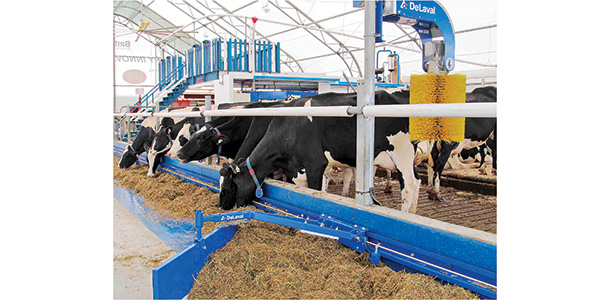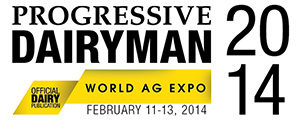DeLaval Farm Credit Dairy Center, 6725-6730 and spaces DS93-DS96 An iteration of a familiar cable-and-drive system used to scrape manure from barn alleys will soon be available to push up cattle feed.
DeLaval will display the new technology, named FPM300, for the first time in the U.S. at World Ag Expo in Tulare, California, in February. During the front half of 2014, the U.S. will receive several reference or test farm installations, and by the third quarter, the technology should be available for purchase.
“We’re of the opinion there aren’t any similar products like it in the marketplace,” says Mark Futcher, DeLaval’s North American marketing manager for automatic milking.
Futcher says dairy producers have been asking for a simple technology for feed push-up. He believes the company’s forthcoming automatic feed pusher is more than just simple in design but also scalable, flexible and durable.
The system’s two-horsepower drive unit moves a high-tension rope along a rail which is mounted to the concrete feedcurb or feedface upwards of 1,400 feet. It can be installed on a single feedfront or facing feedfronts as in a typical drive-through alley.
Futcher says the unit is feasible for use in tiestall, conventional freestall, dry lot and even cross-ventilated facilities with multiple feedfronts.

“In that way, the ploughs would never cross the manure-laden area, as they would stop shy of the cow traffic lane.”
Futcher says the technology has a number of advantages to “robotic” feed pushing technologies, including no downtime for recharging.
“We’re utilizing some mechanical aspects in the design of the system that are quite familiar and comfortable to the producer as compared to what some might consider ‘higher technologies’ or robots. Dairymen are quite bullish on simple,” he says.
The travel speed of the new feed pusher is about 20 feet per minute per plough. DeLaval recommends producers who install the system operate it routinely, thereby increasing the number of times fresh feed is pushed up on a dairy as compared to what may be done manually today and while saving the cost of labor, fuel and equipment wear.
“Because this isn’t battery-operated, it can theoretically be in operation 24 hours per day,” Futcher says.
The innovation has been in development and revision for a number of years in central Europe and is already installed on two dairies in Canada. The name of the product stands for Feed Pusher (Mechanical) version 3.
“Anything that can be implemented on-farm to increase the management and efficiency of feed, the highest input cost of milk production, is a good thing,” Futcher says. PD
PHOTO
DeLaval’s new FPM300 will be on display for the first time in the U.S. at World Ag Expo in Tulare, California, in February. Courtesy photo of DeLaval.

Walt Cooley
Editor
Progressive Dairyman





